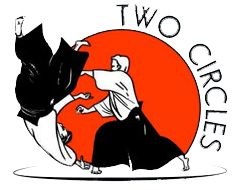Training
In aikido, as in virtually all Japanese martial arts, there are both physical and mental aspects of training. The physical training in aikido is diverse, covering both general physical fitness and conditioning, as well as specific techniques. Because a substantial portion of any aikido curriculum consists of throws, the first thing most students learn is how to safely fall or roll. The specific techniques for attack include both strikes and grabs; the techniques for defense consist of throws and pins. After basic techniques are learned, students study freestyle defense against multiple opponents, and in certain styles, techniques with weapons.
How is Aikido training conducted?
Aikido practice begins the moment you enter the dojo! Trainees ought to endeavor to observe proper etiquette at all times. It is proper to bow when entering and leaving the dojo, and when coming onto and leaving the mat. Approximately 3-5 minutes before the official start of class, trainees should line up and sit quietly in seiza (kneeling). (If you are unable to sit in seiza, you may sit cross-legged instead if you ask you instructor).
The only way to advance in Aikido is through regular and continued training. Attendance is not mandatory, but keep in mind that in order to improve in Aikido, one probably needs to practice at least twice a week. In addition, insofar as Aikido provides a way of cultivating self-discipline, such self-discipline begins with regular attendance.
Aikido training encompasses more than techniques. Training in Aikido includes observation and modification of both physical and psychological patterns of thought and behavior. In particular, you must pay attention to the way you react to various sorts of circumstances. Thus part of Aikido training is the cultivation of (self-) awareness.
The following point is very important: Aikido training is a cooperative, not competitive, enterprise. Techniques are learned through training with a partner, not an opponent. You must always be careful to practice in such a way that you temper the speed and power of your technique in accordance with the abilities of your partner. Your partner is lending his/her body to you for you to practice on — it is not unreasonable to expect you to take good care of what has been lent you.
Aikido training may sometimes be very frustrating. Learning to cope with this frustration is also a part of Aikido training. Practitioners need to observe themselves in order to determine the root of their frustration and dissatisfaction with their progress. Sometimes the cause is a tendency to compare oneself too closely with other trainees. Notice, however, that this is itself a form of competition. It is a fine thing to admire the talents of others and to strive to emulate them, but care should be taken not to allow comparisons with others to foster resentment, or excessive self-criticism.
Roles of uke and tori
Aikido training is based primarily on two partners practicing pre-arranged forms (kata) rather than freestyle practice. The basic pattern is for the receiver of the technique (uke) to initiate an attack against the person who applies the technique – the tori, also referred to as nage (when applying a throwing technique), who neutralises this attack with an aikido technique.
Initial attacks
Aikido techniques are usually a defense against an attack; therefore, to practice aikido with their partner, students must learn to deliver various types of attacks. Although attacks are not studied as thoroughly as in striking-based arts, “honest” attacks (a strong strike or an immobilizing grab) are needed to study correct and effective application of technique.
Many of the strikes ,of aikido are often said to resemble cuts from a sword or other grasped object, which indicates its origins in techniques intended for armed combat. Other techniques, which appear to explicitly be punches, are also practiced as thrusts with a knife or sword. Kicks are generally reserved for upper-level variations; reasons cited include that falls from kicks are especially dangerous, and that kicks (high kicks in particular) were uncommon during the types of combat prevalent in feudal Japan. Some basic strikes include:
Basic grabs
- Single-hand grab
- Both hands grab one hand
- Both-hands grab two hands
- Shoulder grab
- Chest grab
Multiple attackers and randori
Technique performed against two attackers.
One feature of aikido is training to defend against multiple attackers, Freestyle / semi freestyle (randori, or jiyūwaza) practice with multiple attackers is a key part of most curricula and is required for the higher level ranks. Randori exercises a person’s ability to intuitively perform techniques in an unstructured environment.Strategic choice of techniques, based on how they reposition the student relative to other attackers, is important in randori training. For instance, an ura technique might be used to neutralise the current attacker while turning to face attackers approaching from behind.
Weapons
Weapons training in aikido traditionally includes the short staff (jō), wooden sword (bokken) and knife (tantō).Today, some schools also incorporate firearms-disarming techniques. Both weapon-taking and weapon-retention are sometimes taught, to integrate armed and unarmed aspects, although some schools of aikido do not train with weapons at all. Others, such as the Iwama style of Morihiro Saito, usually spend substantial time with bokken and jō, practised under the names aiki-ken, and aiki-jō, respectively. The founder developed much of empty handed aikido from traditional sword and spear movements, so the practice of these movements is generally for the purpose of giving insight into the origin of techniques and movements, as well as vital practice of these basic building blocks.

